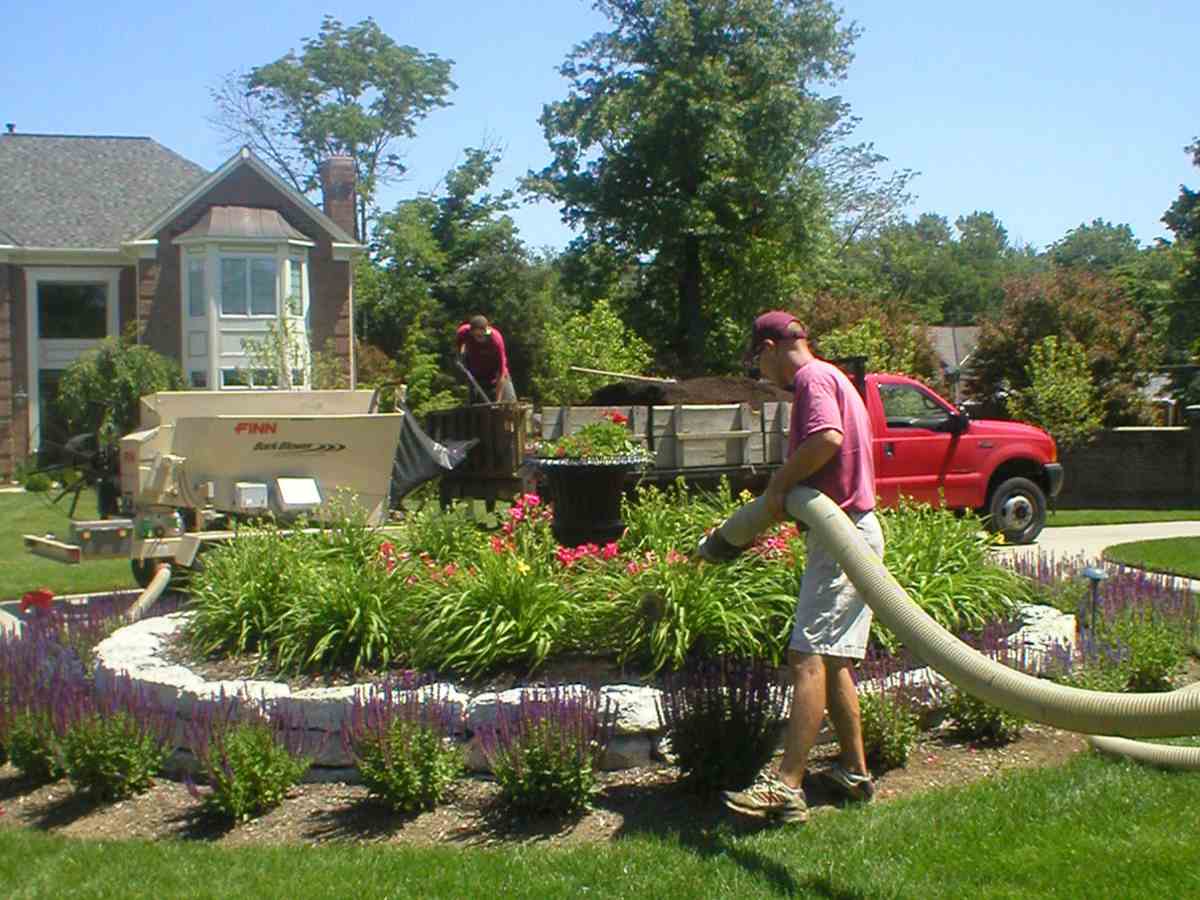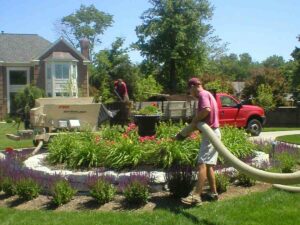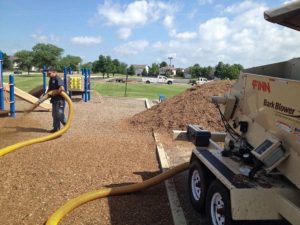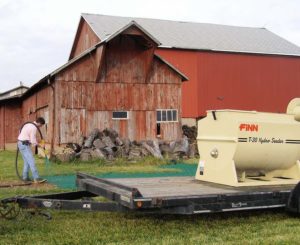How to Lay Mulch Evenly – When & Why to Use a Mulch Blower

Share this article!
Understanding the best way to spread mulch evenly can mean the difference between a great-looking, environmentally-friendly landscape, and one that falls short in both areas. From spreading mulch basics to how to spread mulch evenly, and when to use a mulch blower to achieve the desired results, these landscaper insider tips can help elevate your next project’s aesthetics and help you get the most out of your investment.
Problems with Laying Mulch by Hand
Hand-laying mulch can be a great way to control mulch application on a small scale, but for areas of any moderate size, hand mulching can be costly both in terms of time and materials.
Hand mulching can also be difficult to even out, and if mulch is too deep in places, or too shallow, any plants in the area may have difficulties establishing or continuing to grow well. It can be easy to over-mulch when laying by hand as well, since most areas only require a depth of a few inches of mulch for landscaping to provide the aesthetic and environmental benefits.
Hand mulching also involves a lot of manual labor and heavy lifting. Mulch is generally deposited on the street or driveway, and then needs to be moved by cart or wheelbarrow and transferred to the desired locations, adding to the wear and tear of landscaping, and potentially creating a mess along the way.
When Does it Make Sense to Install Mulch by Hand?
There are certain projects where hand mulching can make sense. For small areas, for example, hand mulching can be a great alternative to mulch blowing. In other cases, if there are areas that simply couldn’t be reached by a hose or are inaccessible for a blower then mulching by hand would offer better results than trying to blow in mulch from too far away.
When and Why to Use a Mulch Blower
For moderate to large areas, using a mulch blower can add efficiency and uniformity to just about any landscaping mulch project. Mulch blowers quickly apply an even layer of your preferred mulch, and can be used to support existing environmental objectives like erosion control or soil remediation.
Benefits of Spreading Mulch with a Mulch Blower
1. Speed
The most obvious benefit to using a mulch blower is the time it takes to get from start to finish on a project. Many yards of mulch can be applied in a matter of minutes, depending on the area and precision required.
2. Cost
Installing mulch by hand can range in price from an average of 60 to 80 cents per square foot, or between $50-$100 per hour depending on the project.
Mulch blowing, by comparison, starts at about 40 cents per square foot to 65 cents per square foot. However, the larger the project, the cheaper mulch blowing tends to become. For example, for landscapers looking to plan out their mulching costs, you can expect to break it down, on average, and accounting for differing mulch prices, labor costs, and regional differences, similar to the following:
| Area to be Mulched: 2,000 yards / year | Conventional Hand Mulching | Mulch Blowing |
| Materials | $58,000 | $40,600 |
| Labor | $60,000 | $8,400 |
| Average cost/year materials + labor | $118,000 | $49,000 |
On average, mulch blowing can save about 30% on material costs and about 25-30% on labor assuming the same annual mulch coverage (2,000 yards/year.)
3. Even Mulch Distribution
Even mulch distribution plays an important role in both keeping your soil and plants healthy while also enhancing landscaping’s visual appeal. Mulch acts as a soil insulator, moderating soil temperature, and helps retain water in the soil. So, if the mulch is uneven or patchy, plants may struggle to get the nutrients they need in some places, or dry out too quickly in others. Mulch also limits the growth of weeds, and areas where mulch is too thin may allow more weeds or undesired plants to take root.
A consistent, even layer of mulch helps protect plants from temperature swings in either direction, helps retain healthy levels of moisture and soil nutrients, and has the added benefit of providing great-looking landscaping.
4. Access Hard to Reach Areas
Using a mulch blower is a great way to get mulch evenly into hard-to-reach areas. In places where it would take a long time or careful navigation to reach, such as steep slopes or generally difficult terrain, mulch can often be blown more easily and precisely. Mulch blowers come with many feet of hose that can be maneuvered over fences or around obstacles to place mulch exactly where it is needed.
5. Precise Application
Mulch blower hoses can be easily moved and aligned for precise landscaping needs, reaching areas like garden beds, tree and shrub bases, edging and trim, and slopes that would otherwise take a lot of time and labor to hand-mulch. Large, maneuverable hoses facilitate reach and precision with minimal disruption.
6. Minimize Damage to Lawns and Landscaping
Using a mulch blower is often less disruptive than hand mulching. Lightweight blower hoses can be carried across lawns easily, eliminating the need for repeated wheelbarrow loads and lots of foot traffic over existing lawn or landscape features. Often only a single person is required to blow mulch, minimizing the potential for foot traffic damage and overall mess.
Mulch blowing also typically leaves behind less mulch mess and residue than hand mulching, as no large piles of mulch are needed to dump and then redistribute, and then subsequently be cleaned up after.
Using Mulch Blowers to Lay Mulch Can Save Landscapers Time and Money
Installing mulch with a blower is an efficient, effective way to get better-looking, harder-working landscaping. From increased curb appeal to added erosion control and soil nutrient balance, using a mulch blower can protect plants and soil for a landscape that’s set up to thrive. For more questions about how to lay mulch evenly, or spreading mulch tips, contact our mulch blowing pros.
Folow Finn Corporation on Social
How to Lay Mulch Evenly – When & Why to Use a Mulch Blower
Understanding the best way to spread mulch evenly can mean the difference between a great-looking, environmentally-friendly landscape, and one that falls short in both areas. From spreading mulch basics to how to spread mulch evenly, and when to use a mulch blower to achieve the desired results, these landscaper insider tips can help elevate your next project’s aesthetics and help…
Bark & Mulch Blowing 101
One of the best ways to enhance soil composition, prevent erosion, and improve the aesthetics of any landscaping project is to utilize bark and mulch blowing. For our purposes, bark and mulch blowing are effectively the same thing, and can generally be used interchangeably. Bark and mulch are both great choices to prevent weed growth and invasion, improve soil quality…
Hydroseed vs. Sod vs. Grass Seed
If you’re starting a lawn from scratch, you’ve probably come across the three common methods for seeding: sod, grass seed, and hydroseed. In order to determine the best choice for your yard, you may want to ask yourself a few questions before you get started, and familiarize yourself with each of the processes so you can make the right choice…



